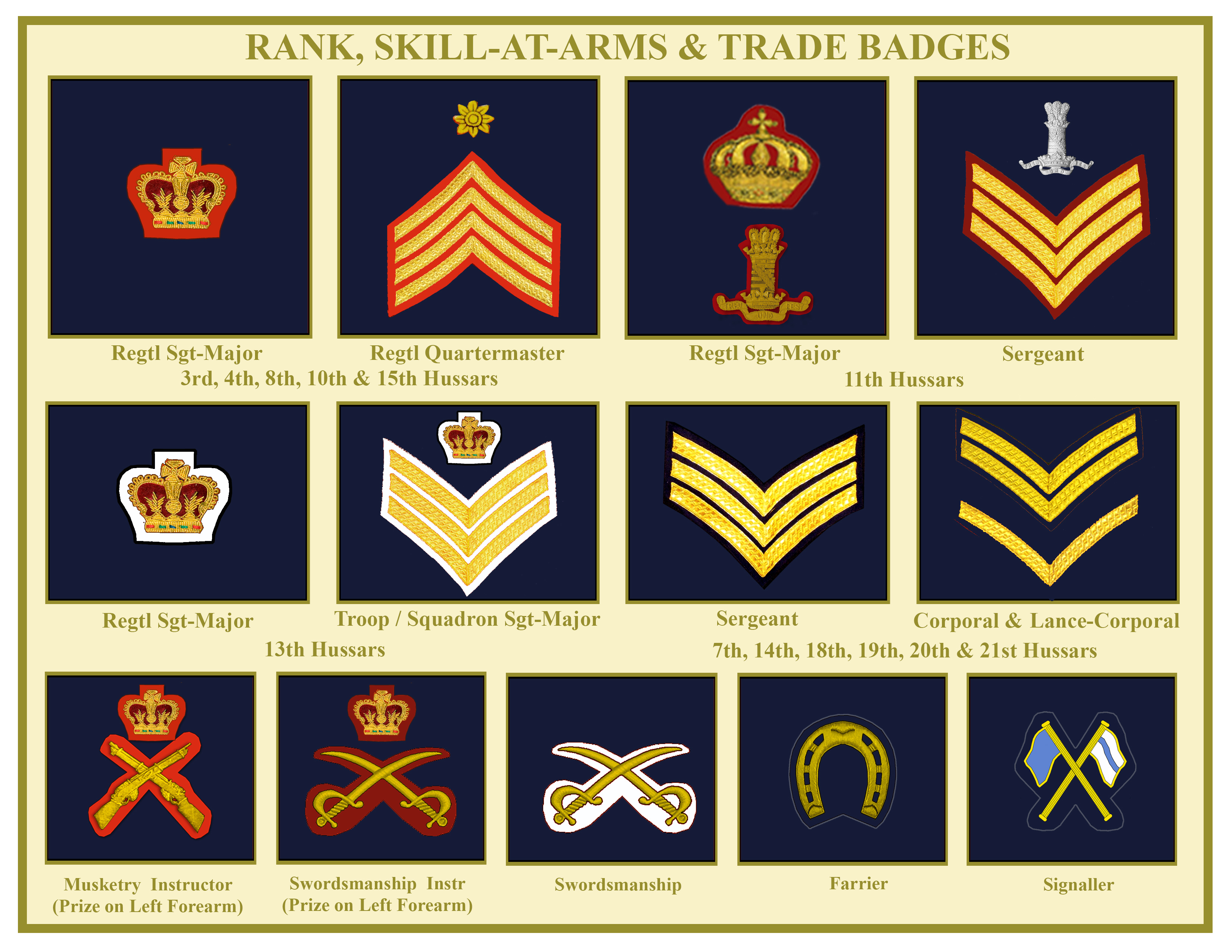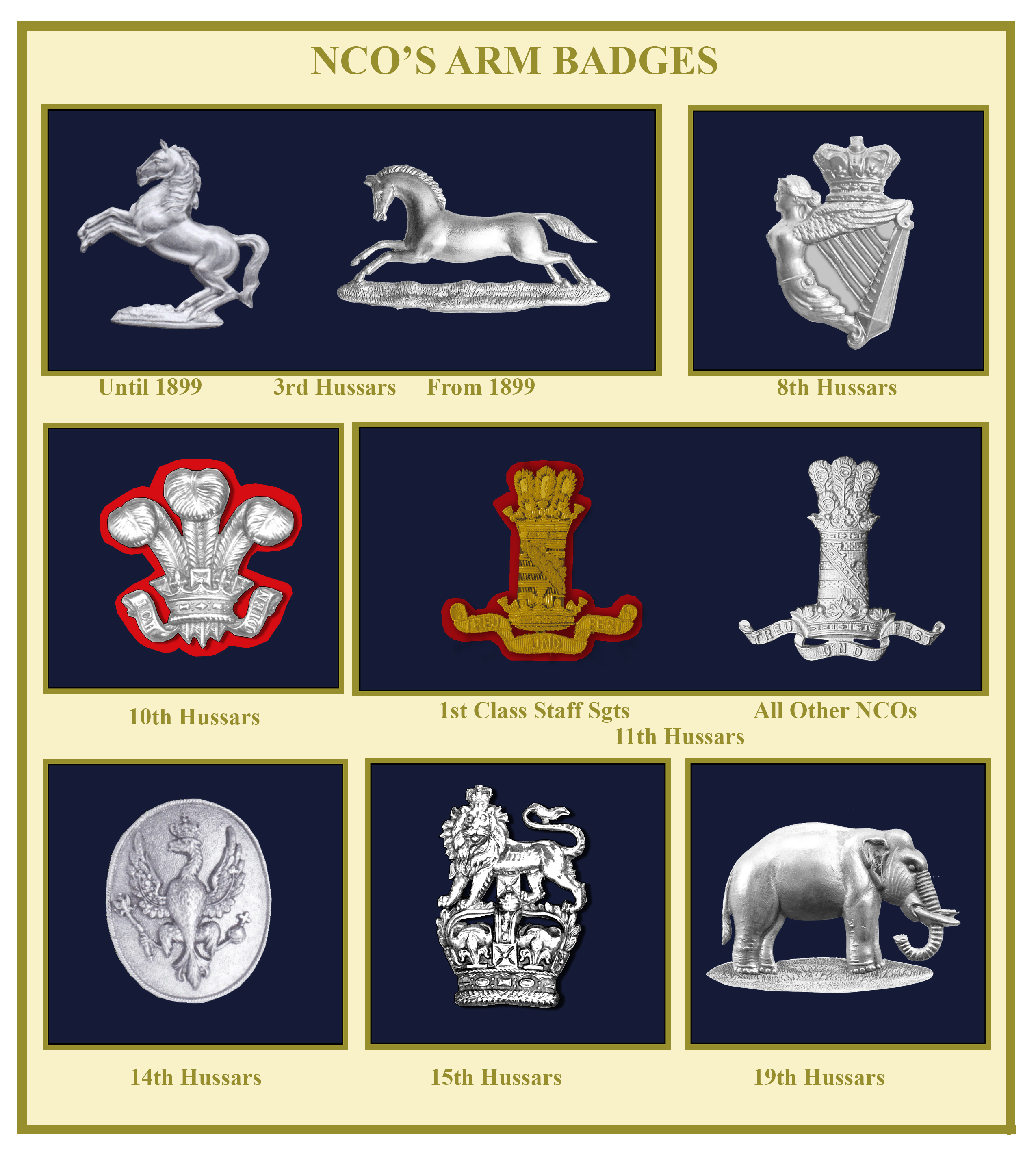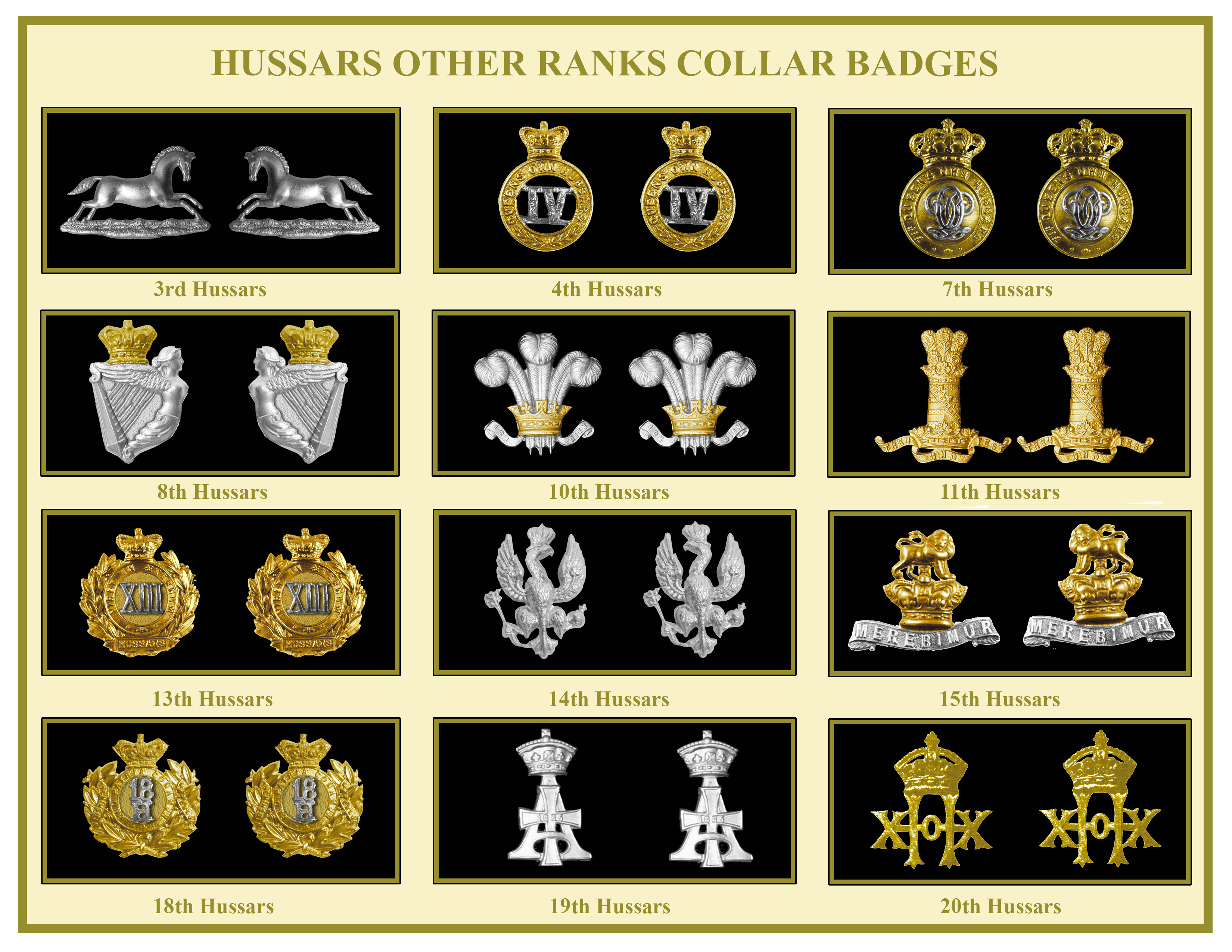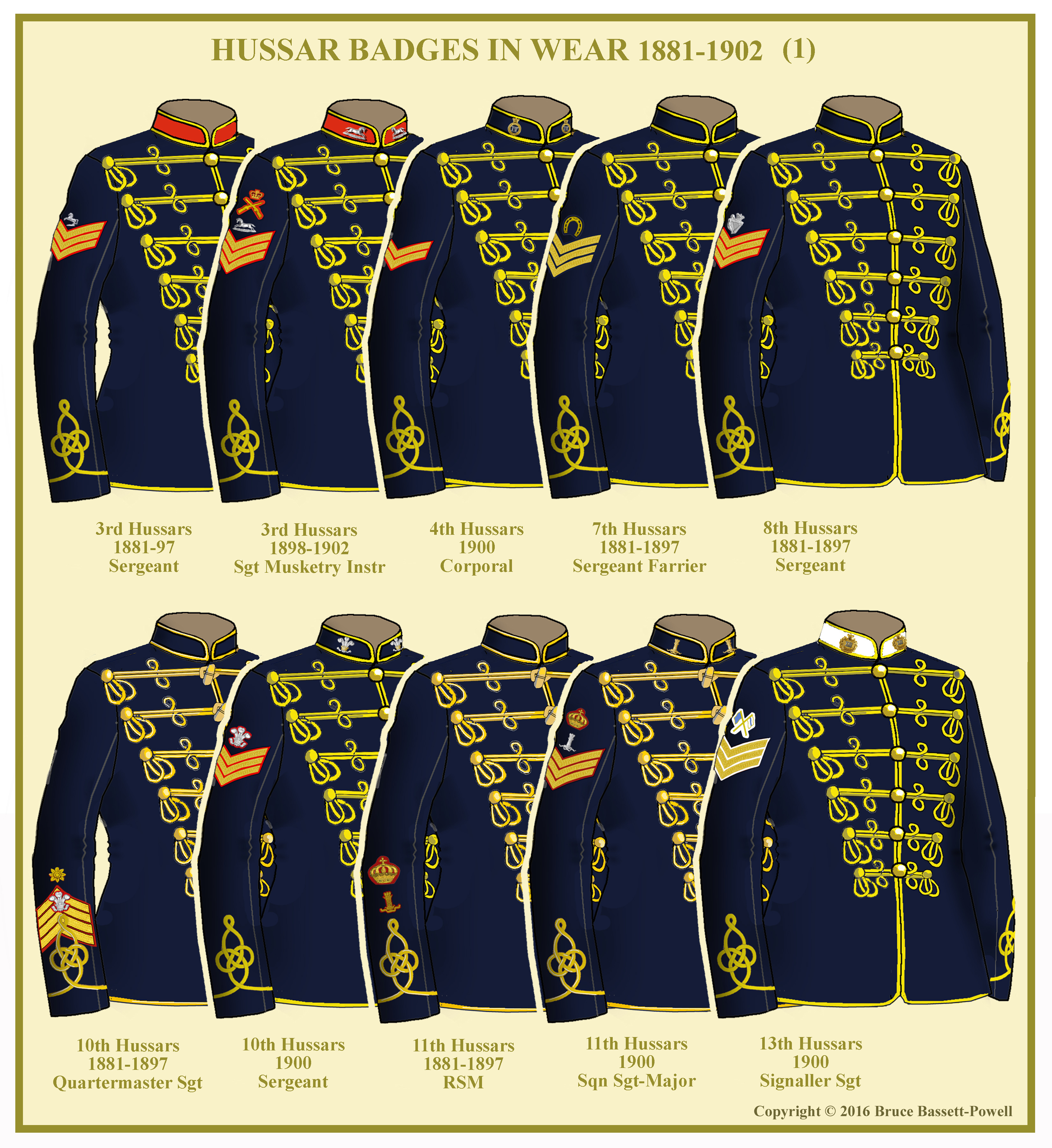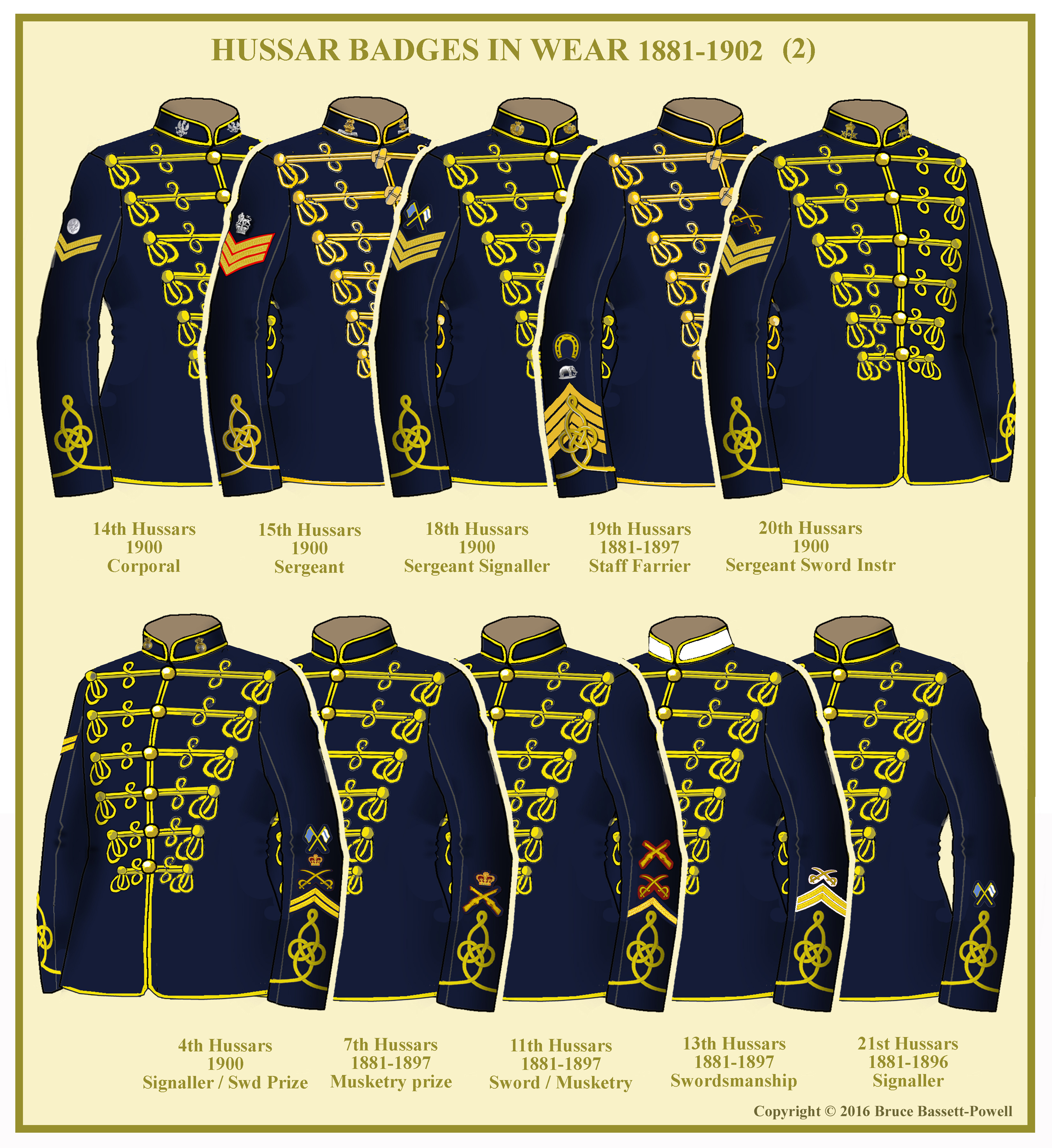UNIFORMS, ARMS & EQUIPMENT - HUSSARS
UNIFORM BADGES WORN BY OTHER RANKS
The 1881 reforms that affected the nomenclature of other ranks have been discussed at length throughout this series. For clarification, the main divisions were Warrant Officers, Staff-Sergeants 1st Class, Staff-Sergeants 2nd Class, Sergeants, corporals and Privates. Late in 1881, Regimental Sergeant-Majors, Bandmasters, and senior specialist ranks (Farriers, Quartermasters etc) were raised to Warrant status.
BADGES OF RANK
Apart from the uniform distinctions described in the previous section the rank badges and chevrons were to be worn on the right arm only. All chevrons, points down were to be worn above the elbow and badges for Regimental Sergeant-Majors and chevrons points up worn below the elbow. Only specialist ranks as described above wore four chevrons points up along with a badge of specialty above. These were the only points up chevrons worn on the right arm.
As with all cavalry, hussar chevrons were of gold lace and certain regiments had backings that were not of tunic colour. The 3rd, 4th, 8th, 10th and 15th regiments had scarlet backings. The 10th apparently did not adopt them until around 1894. The 11th Hussars had crimson backings and the 13th, white. Except for the 13th the backings are difficult to discern in photographs and evidence emerges from original paintings and anecdotal evidence.
In the illustration showing the ranks for hussars it is important to note that the crown used by the 11th Hussars was the Albert crown which apparently wasn’t changed until after 1902. Also with the 11th Hussars I have chosen to add the sergeants arm badge as the portrayal would look false without it.
It should also be noted that Lance-Corporals in the 10th and 19th Hussars wore two chevrons instead of one.
REGIMENTAL ARM BADGES FOR NCO.s
Before 1902, seven regiments had adopted sergeants or NCO arm badges. Many of these badges had ancient antecedents.
3rd Hussars – A silver rearing horse badge was officially authorised in 1884 and worn by sergeants but not the RSM, lance-sergeants, corporals or lance corporals. It was, however worn by the Kettledrummer. There is photographic evidence that it was worn before 1884 and that it was worn on the chevrons –at least on the stable jacket in 1882. As stated before, this badge was also worn as a collar badge and folding field cap badge by officers. When the long horse badge was adopted for the collar badge in 1898 it was also adopted as the arm badge.
8th Hussars – The harp was worn as an arm badge in this regiment as early as 1843. Until 1859 an embroidered version was worn with the Royal Crest above. It was changed to silver in 1867. Photographs show it being worn on the stable jacket chevrons until 1890 or so. It was definitely worn above the chevrons on all orders of dress after that date. Corporals and below did not wear the badge until after 1902
10th Hussars – The Prince of Wales’s Feathers appeared as an arm badge during the Napoleonic Wars as evidenced by a Denis Dighton print in 1813. It may be the oldest arm badge worn. It was worn with a crown (confusingly above or below) until 1868 when the embroidered badge was changed to silver. After that date it was worn above the chevrons with a scarlet cloth backing. The QMS (and probably staff Farrier) wore it on the chevrons until after the 1890s.
11th Hussars – The Prince Consorts Crest and Motto had been used as an embroidered arm badge along with the Albert Crown since the 1850s. When the silver version of the badge was authorised in 1876, the embroidered crest and crown continued to be worn by the RSM and Troop / Squadron Sergeant-Majors until well into the next century. Silver badges were worn on the chevrons (without backing) until at least 1890. Corporals and Lance corporals did not wear the badge.
14th Hussars – An 1832 painting of a sergeant by Dubois Drahonet shows an embroidered arm badge beneath a crown. When they were first worn is not known but experts agree that it was worn since at least 1830. The crown as part of the badge was removed in 1860. The silver badge was authorised in 1867 along with a white metal version for corporals and lance-corporals.
The RSM, QMS and staff-farriers did not wear the badges.
15th Hussars – A bullion crown (of Hanoverian or later Victorian type) had been worn by NCOs of the regiment since 1801 but was not worn after 1860. The royal crest was permitted for wear on officer’s appointments since the 1768 Royal Warrant. It was therefore logical that the design in silver should be authorised as an arm badge for NCOs in 1888. Worn above the chevrons for most NCOs, it was not worn by the RSM during this period.
19th Hussars – The Elephant, worn above the chevrons was approved for wear in 1874. It was carried on officers appointments in memory of the old 19th regiment disbanded in 1821. They may have been made of silver for the NCOs but the only confirmation comes in 1883 when they were ordered from a Birmingham silversmith. They were worn by all Warrant officers and NCOs during the period.
BADGES OF TRADE & SKILL-AT-ARMS
These badges were extensively described in the Heavy Cavalry section and only a selection are shown here. Long service chevrons were also described there and were of worsted yellow cloth with tunic colour backing (except for the 13th Hussars who had white backing)
COLLAR BADGES
Collar badges for other ranks were made of bi-metal where needed or white-metal. They were the same design as for officers. Note the animal’s heads always pointed to the front on whichever side of the collar.
BADGES IN WEAR


